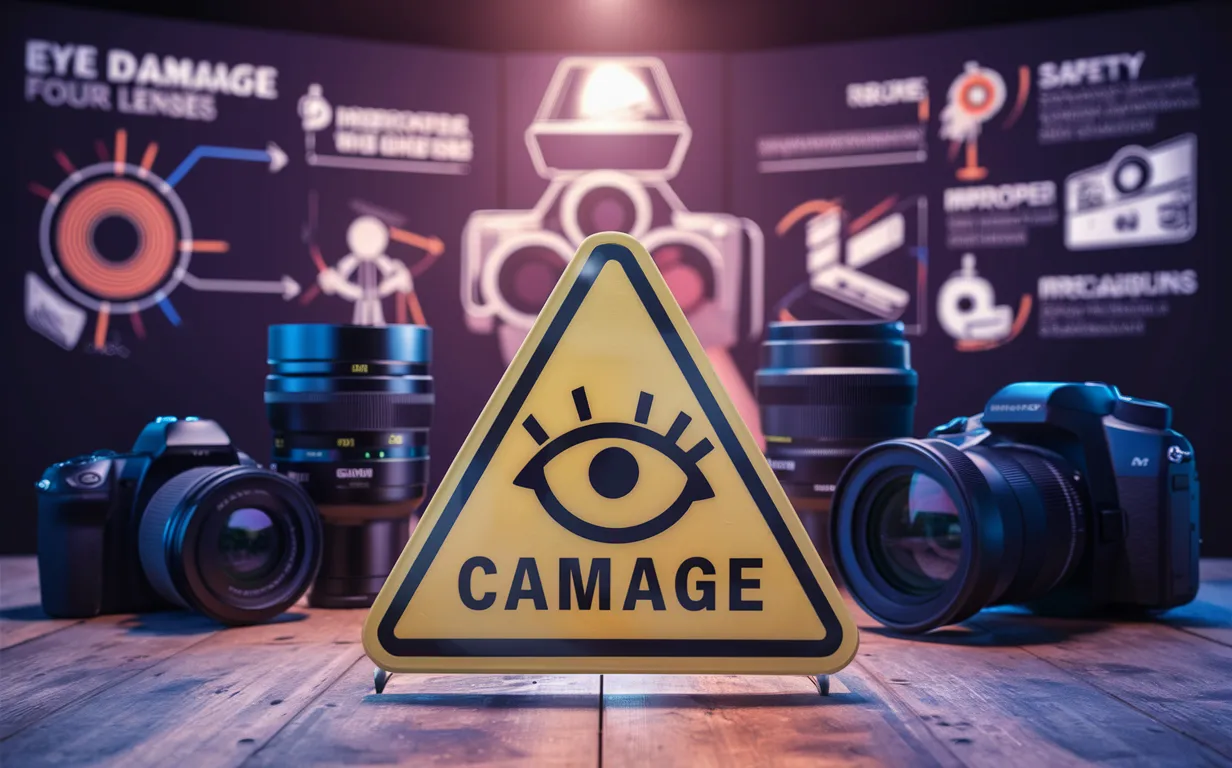Many photographers have likely pondered the question, “Can camera lenses cause eye damage?” As photography becomes increasingly integrated into our daily lives through smartphones and DSLRs, it’s crucial to explore whether camera lenses pose any risks to our eye health. While lenses are designed to capture stunning images, there are specific scenarios where they might contribute to eye damage. This article delves into potential risks, such as exposure to harmful rays, direct eye contact with light sources, and prolonged use of viewfinders, and offers practical advice on mitigating these risks.
Direct Sunlight Through Optics
One of the most significant risks associated with camera lenses is exposure to direct sunlight. When a lens is pointed towards the sun, it can concentrate the sunlight, potentially causing retinal damage if someone looks through the viewfinder or directly into the lens. The sun emits ultraviolet (UV), visible, and infrared (IR) wavelengths, all of which can harm the eye. Even brief exposure to concentrated sunlight can elevate retinal irradiation to levels that may damage light-sensitive cells, leading to long-term conditions like macular degeneration.
Precautionary Measures
- Never look directly at the sun through a camera lens: Always use solar filters specifically designed for photography.
- Use lens hoods: These help to block extraneous light and reduce the risk of accidental sun exposure.
- Be aware of reflections: Avoid photographing reflective surfaces that could direct sunlight into your eyes.
Prolonged Viewfinder Use
Another concern is the prolonged use of optical viewfinders. Extended periods of focusing light through the dense lens system of a camera onto the retina can cause eye strain. Older film SLRs, which often lacked diopter correction rings, may have exacerbated these issues for users who required vision correction.
However, modern DSLR and mirrorless camera viewfinders are designed to minimize such risks. They typically have diopter correction rings, allowing users to adjust the viewfinder for their vision needs, and the light levels are optimized for contrast rather than brightness. Despite this, it’s wise to take regular breaks during long photography sessions.
Reducing Eye Strain
- Take frequent breaks: Look away from the viewfinder every 20 minutes and focus on a distant object.
- Use artificial tears: These can help keep your eyes moist and reduce strain.
- Blink often: This helps to lubricate your eyes and prevent dryness.
Proximity to High-Powered Lenses
High-powered lenses, such as long telephoto lenses or high-magnification macro lenses, gather light intensely and can potentially cause eye damage if viewed from close range. These lenses concentrate light into a small area, and accidental direct exposure can harm the retina.
Safety Tips
- Never look through the front element of a high-powered lens: Always use the viewfinder or an eyepiece.
- Be cautious with macro lenses: Ensure that the lens is pointed away from your eyes when not in use.
UV Ray Exposure
Long-term exposure to UV radiation is a known risk factor for eye conditions such as cataracts and pterygiums (growths on the eye). Most camera lenses include UV-blocking coatings, which mitigate this risk. However, photographers who spend extensive time outdoors, especially in high-altitude or desert environments, may be at higher risk due to increased UV exposure.
Protective Measures
- Wear UV-blocking sunglasses: These protect your eyes from harmful UV rays.
- Regular eye exams: Monitor for early signs of UV-related damage, especially if you spend a lot of time outdoors.
Contact Lens Wear Precautions
Photographers who wear contact lenses should be aware of specific risks. Extended wear can increase the chance of corneal infections and thinning. Contact lenses concentrate incoming light directly onto the cornea, which can be problematic during prolonged viewfinder use. Microscopic debris or deposits on the lenses can also act as tiny lenses, increasing light concentration on small corneal areas.
Recommendations for Contact Lens Wearers
- Remove contacts periodically: Give your eyes a break and use artificial tears.
- Ensure proper hygiene: Always wash your hands before inserting or removing contact lenses.
Evaluating Lens-Related Injuries
Diagnosing whether a particular eye condition was caused by camera lens exposure can be challenging. Symptoms like blurred vision, eye pain, or photophobia might not appear immediately. Any persistent symptoms following suspected lens exposure warrant prompt medical evaluation.
Risk Reduction Strategies
While the chances of eye injury from typical camera use are low, there are several practical steps photographers can take to further minimize risks:
- Use lens hoods: They help to block extraneous light from entering the lens.
- Avoid direct sun photography without filters: Use appropriate filters to block UV/IR wavelengths.
- Take regular breaks: This is especially important during prolonged viewfinder use.
- Wear 100% UV-blocking sunglasses: When working outdoors, these protect your eyes from harmful UV rays.
- Get regular eye exams: Monitor for any signs of cumulative light exposure damage.
- First aid knowledge: Be prepared to handle acute eye injuries like flash burns promptly.
- Specialized protective eyewear: For high-risk activities like solar photography, invest in proper protective gear.
Conclusion
Understanding the potential risks associated with camera lenses and taking appropriate precautions can help photographers protect their eyes while continuing to pursue their passion. Whether it’s avoiding direct sunlight through lenses, taking breaks during prolonged viewfinder use, or wearing UV-protective eyewear, these measures can significantly reduce the likelihood of eye damage. By staying informed and vigilant, photographers can enjoy capturing beautiful images without compromising their eye health.
Final Thoughts
Maintaining eye safety is crucial for photographers. By understanding the risks and implementing protective strategies, you can ensure that your passion for photography does not come at the expense of your vision. Remember to take breaks, use appropriate filters, and get regular eye exams to keep your eyes healthy and your images sharp.



